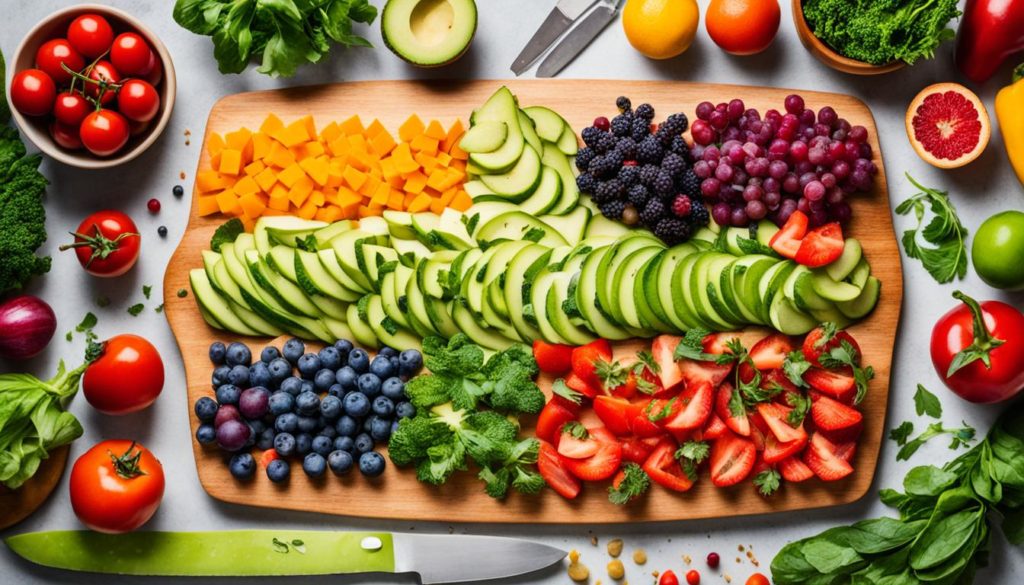Did you know that nearly 90% of Americans don’t get enough fruits and veggies? This fact is shocking since these foods are key for a balanced diet. Healthy eating is about choosing a variety of nutrient-packed foods. This includes whole grains, lean proteins, and staying hydrated. Whether you’re trying to up your calories when sick, or choosing the right foods after medical treatments, knowing about nutrition is key. Websites like MyPlate and advice from the USDA and HHS can help. They make it easy to find a nutritious eating plan that’s right for you. Let’s look at the main parts of eating healthy and how you can make these changes for better health.
Key Takeaways
- Healthy eating habits involve a balanced diet including a variety of fruits, vegetables, whole grains, and lean proteins.
- Hydration is a crucial component of maintaining good nutrition.
- Utilize resources like MyPlate for personalized nutrition tips and dietary guidelines.
- Make conscious, nutrient-rich food choices to support overall health and well-being.
- Gradual implementation of dietary changes leads to sustainable health improvements.
- Select food options tailored to specific conditions or health needs.
The Importance of Balanced Diets
A balanced diet is key for good health and well-being. It gives us the energy and nutrients we need. Based on how active you are, knowing how much to eat helps keep a healthy weight. It keeps our nutrition in check.
Understanding Macronutrients
Our bodies need macronutrients, like proteins, carbs, and fats, in large amounts. They’re essential for making energy, repairing tissues, and growth. Proteins fix muscles and boost our immune system. Carbs are our main energy source.
Fats are important too. They help our cells work and produce hormones. Getting the right mix of these nutrients is important for staying healthy.
The Role of Micronutrients
Micronutrients are also critical, even though we need them in smaller amounts. They’re vitamins and minerals that stop deficiencies and support our body. Vitamins aid in immunity, energy making, and blood clotting.
Minerals, like calcium, help our bones, and iron carries oxygen in our blood. Following the Recommended Dietary Allowances (RDAs) for these nutrients is important. It ensures we get what we need daily.
In conclusion, a diet balanced in macronutrients and micronutrients is crucial. It helps us maintain our health and feel our best.
Nutrition Tips for a Healthy Lifestyle
Starting a healthy lifestyle means choosing wisely what you eat. It’s about adding essential nutrients and keeping your diet balanced. In this piece, I’ll share key nutrition tips to help point you in the right direction.
Choosing Whole Grains
Eating whole grains is key for long-lasting energy and getting many nutrients. Foods like quinoa, brown rice, and whole wheat pasta are rich in dietary fiber. Fiber is great for digestion and helps you feel full longer. Make sure to include these grains in your meals to keep up your energy all day.
Incorporating Healthy Fats
It’s important to add healthy fats into your diet for cell health and to make hormones. Foods like avocados, nuts, and olive oil are full of healthy fats. They also have omega-3 fatty acids, which are good for your brain and can reduce swelling. Getting the right balance of healthy fats is a big part of good health and metabolism.
Choosing whole grains and adding healthy fats can make your diet much better. These tips aim for a balanced way of eating that boosts your health for the long run.
The Benefits of Meal Planning
Meal planning changes the game for keeping healthy habits. It helps you stick to dietary guidelines and manage your portions better. When you plan your meals, you’re less likely to choose food on a whim.
With meal planning, you get to make home-cooked meals that fit your calorie needs and tastes. This way, you can eat meals that are both balanced and rich in nutrients. It’s all about having a meal schedule that’s good for you.
Tools like MyPlate Plan make it easy to create meal plans that build healthy habits. Planning ahead means you’re more likely to eat the right portion sizes. It also helps prevent eating too much.
Here’s a quick look at the benefits:
- Adheres to dietary guidelines
- Improves portion sizes control
- Reduces impulsive food choices
- Facilitates preparation of home-cooked meals
- Encourages the adoption of healthy habits
A good meal planning strategy is key. It makes sure every meal helps with your nutrition and energy levels.
Healthy Recipes for Every Meal
Adding healthy recipes into our daily meals helps maintain a balanced diet. We should focus on whole grains, healthy fats, and proteins. This way, we can enjoy tasty and nutritious meals for breakfast, lunch, and dinner.
Breakfast Ideas
It’s important to start the day with nutritious meals. My top breakfast choices are oatmeal with fresh fruits, scrambled eggs with spinach, and Greek yogurt with nuts. These give a good mix of fiber and protein, keeping us energized in the morning.
Lunch Ideas
I prefer salads for lunch, packed with proteins and grains. A favorite is a mixed greens salad with grilled chicken, quinoa, and veggies, topped with olive oil dressing. These meals are balanced and help control hunger during the day.
- Mixed Greens Salad with Grilled Chicken
- Quinoa and Black Bean Bowl
- Turkey Wrap with Whole Grain Tortilla
Dinner Recipes
Dinner helps us refuel. I love making meals with lean proteins, like baked salmon, along with steamed veggies and brown rice. Adding healthy fats, like avocado, brings extra nutrients without losing taste. These dinners aid in recovery and support a healthy lifestyle.
- Baked Salmon with Steamed Broccoli
- Grilled Tofu Stir-Fry
- Lentil Soup with Whole Grain Bread
Mindful Eating Practices
Mindful eating can really change how we view food and our diets. By paying close attention while we eat, we understand our hunger and fullness better. This helps us control what and how much we eat.

At the heart of mindful eating is learning to spot emotional eating. Many times, we eat certain foods because we’re stressed. By noticing when we do this, we can handle food cravings better. We can choose healthier options. This helps us deal with stress better and eat a balanced diet.
Taking time to enjoy the taste, feel, and smell of food is important too. Eating slowly and with joy makes meals more satisfying. It also helps with digestion and making good food choices. This method leads to a good, lasting dietary habits. It makes sure we have a healthy and happy relationship with food.
Here’s a table summarizing the principles and benefits of mindful eating practices:
| Principle | Benefit |
|---|---|
| Awareness of Hunger and Fullness | Better regulation of dietary habits |
| Recognition of Emotional Eating | Improved stress management and reduced food cravings |
| Savoring Food | Enhanced dining experience and better digestion |
| Healthier Food Choices | Long-term positive dietary habits |
Adding mindful eating to our daily life helps us enjoy food more. It makes our diet healthier and supports our whole wellbeing.
Weight Management Through Diet
Weight management is key to staying healthy and feeling good. It involves watching portion sizes and knowing how many calories I need. By doing this, I make sure I get the right amount of energy from my food. This helps my body work well and keeps my activity levels up.
Controlling Portion Sizes
Portion size is super important for keeping my weight in check. Using tools like the Handy Guide to Portion Sizes shows me how much food I should eat. This stops me from eating too much. By understanding portion sizes, I can eat foods that are good for me without going over my calorie limit. This helps me stay at a healthy weight.
Caloric Needs
Knowing how many calories I need is crucial to balance energy. This depends on my age, gender, weight, and how active I am. I have to eat enough calories to fuel my body while not gaining extra weight. Eating foods that are rich in nutrients helps me hit my calorie goals and stay healthy.
| Nutrient-Rich Foods | Portion Size Control | Caloric Needs |
|---|---|---|
| Fruits and Vegetables | Handy Guide Tool | Based on Activity Levels |
| Lean Proteins | Meal Planning | Personalized Intake |
| Whole Grains | Mindful Eating | Balance Energy |
Making Healthy Food Choices
Choosing healthy foods is key to good health and balance. It’s smart to look at food labels closely. You should go for organic and local options whenever you can. Let’s dive into these important points.
Reading Food Labels
Reading food labels is a basic but crucial step. It helps you know what’s in your food. This means you can pick foods low in sugar, salt, and bad fats. By doing this, you make sure your diet helps you, not hurts you.
Choosing Organic and Local Produce
Picking organic foods and local veggies and fruits is great for your health. These choices don’t have dangerous chemicals. They’re better for you and your family. And, buying local supports farmers and gets you fresher foods.
Here’s a quick view of why local and organic foods are good:
| Aspect | Organic Foods | Local Produce |
|---|---|---|
| Food Safety | No harmful pesticides | Minimal exposure to preservatives |
| Nutritional Value | High nutrient density | Fresher, retains more nutrients |
| Sustainability | Eco-friendly farming practices | Supports local farmers |
Adding organic and local foods to your meals helps a lot. It means eating safer and more nutritious food. By checking labels and knowing where your food comes from, you eat healthier. Remember, variety and quality are the secrets to eating well.
Healthy Eating Habits: The Food Pyramid
The food pyramid is key for anyone trying to learn about balanced diets. It groups foods and shows how much to eat from each group. It helps us get the nutrients we need every day.
Using the food pyramid guides us in eating a balanced diet. It tells us how much from each group to eat, focusing on fruits, veggies, grains, proteins, and dairy.
- Fruits and vegetables are at the base because they are full of vitamins and minerals.
- Grains, especially whole ones, should be a big part of what we eat each day.
- Proteins like lean meats, beans, and fish are critical for our health.
- Dairy or its alternatives give us calcium and vitamin D for strong bones.
- Fats and sweets are for occasional treats, not everyday foods.
Using the food pyramid makes us smarter about what and how much to eat. It shows portion sizes for each food group. This helps us eat a well-rounded diet.
“The food pyramid has significantly improved my understanding of portion sizes and how to balance my meals,” says one enthusiastic advocate.
Now, let’s look closer at each food group in the pyramid and their serving sizes:
| Food Group | Daily Servings | Examples |
|---|---|---|
| Fruits | 2-4 servings | Apples, oranges, bananas |
| Vegetables | 3-5 servings | Carrots, spinach, broccoli |
| Grains | 6-11 servings | Whole wheat bread, oats, rice |
| Proteins | 2-3 servings | Chicken, tofu, legumes |
| Dairy | 2-3 servings | Milk, cheese, yogurt |
| Fats and Sweets | Use sparingly | Butter, candy, oils |
Getting to know the food pyramid changes how we view diets. It ensures our meals make up a balanced diet. With the pyramid as a guide, a balanced diet is easier for everyone to achieve.
Special Dietary Needs and Preferences
Meeting individual dietary needs and preferences is crucial for a healthy, balanced life. People might choose a vegetarian or vegan diet, or need gluten-free and dairy-free foods. It’s vital to effectively support these special dietary requirements.
Vegetarian and Vegan Diets
A vegetarian diet avoids meat and fish, focusing instead on plants. This diet includes vegetables, fruits, grains, and nuts. Meal planning is essential to ensure intake of protein, iron, and B12. A vegan diet takes it further, excluding all animal products. This includes dairy and eggs. To get enough nutrients, vegans can eat legumes, tofu, and fortified plant milks.
“A well-planned vegetarian or vegan diet can provide all the essential nutrients needed for a healthy life.”—American Dietetic Association
Gluten-Free and Dairy-Free Options
For those with food allergies or intolerances, sticking to a special diet is key. A gluten-free diet is vital for people with celiac disease or gluten sensitivity. It cuts out wheat, barley, and rye for alternatives like quinoa and rice. A dairy-free diet helps those with lactose intolerance or dairy allergies. They can use almond milk, coconut yogurt, and dairy-free cheese for variety and nutrition.
- Replace wheat bread with gluten-free alternatives
- Use almond milk instead of cow’s milk
- Opt for dairy-free cheese on sandwiches and pizzas
Supporting special dietary needs leads to a healthier, balanced life. It ensures that food allergies or intolerances don’t hinder nutrition.
Healthy Snacks and Smoothie Recipes
Eating well all day can be simple. Adding healthy snacks and smoothie recipes to what you eat helps a lot. They’re tasty and make getting important nutrients easy. Let’s look at some great snacking tips and smoothie ideas.

Smart Snacking Ideas
Snacking smart is key to maintaining your energy. Choose healthy snacks that are full of nutrients. They should fill you up without too many calories.
- Fruits and vegetables: Try carrot sticks, apple slices, or grapes for a quick energy boost.
- Nuts and seeds: Almonds, walnuts, and sunflower seeds are great for fats and protein.
- Yogurt: Plain Greek yogurt and a bit of honey give you protein and probiotics.
Delicious Smoothie Recipes
Smoothie recipes are great for adding fruits and veggies into your meals. They’re easy, you can change them up, and they’re good for when you’re out and about.
- Green Power Smoothie: Mix spinach, kale, banana, apple, and almond milk for health.
- Berry Blast: Combine blueberries, strawberries, Greek yogurt, and orange juice for a zesty snack.
- Tropical Delight: Blend mango, pineapple, coconut water, and protein powder for a tropical taste.
Here’s a simple guide to show you how to enjoy these snacks and smoothies daily:
| Time of Day | Smart Snack | Smoothie Option |
|---|---|---|
| Mid-Morning | Apple slices and almond butter | Green Power Smoothie |
| Afternoon | Carrot sticks and hummus | Berry Blast |
| Evening | Mixed nuts and dried fruit | Tropical Delight |
By adding these smart snacking ideas and smoothie recipes to your eating plan, you can reach your nutrition goals easily. You’ll stay energized and enjoy lots of yummy tastes.
Grocery Shopping Tips
When you go grocery shopping, it’s smart to have a plan to make better food choices. A great way to start is by label reading. This helps you choose healthier options by checking the ingredients and nutrition facts. For example, choosing whole grains instead of refined ones is a good move.
Making a meal plan before shopping is another top tip. Meal prep saves you time and stops you from buying things you don’t need. You can make a shopping list from your meal plan. This helps you stick to budget-friendly meals that are satisfying without spending too much.
Trying healthy substitutions is a smart choice. Swap out items like sour cream for Greek yogurt, or regular pasta for whole wheat. This lets you enjoy your favorite foods in a healthier way.
Knowing how to keep your food fresh is key. Food preservation like using sealed containers, freezing, and tracking expiration dates keeps groceries fresh. This reduces waste and saves money.
Here’s a brief summary of these tips:
| Tip | Benefit |
|---|---|
| Label reading | Identifies healthier options |
| Meal prep | Supports budget-friendly meals |
| Healthy substitutions | Enhances nutrient content |
| Food preservation | Reduces food waste |
Adding these tips into your shopping routine leads to a healthier lifestyle. From meal prep to food preservation, making smart choices at the grocery store improves your food’s nutrition. This supports a healthier, organized way of living.
Mindful Eating for Picky Eaters
Dealing with picky eaters, whether kids or adults, can be challenging. With patience and the right methods, we can teach mindful eating habits. These habits improve their nutrition.
Strategies for Kids
Involving kids in meal planning can make them excited to try new foods. Teaching mindful eating early leads to healthier choices. Bring them into the kitchen to help cook. This can make meals fun and something everyone looks forward to.
- Allow kids to choose new fruits or vegetables to try each week.
- Create fun and engaging food presentations.
- Encourage mindful eating by discussing the flavors and textures.
Tips for Adults
Adults can enjoy mindful eating too. Appreciating textures and flavors can change how we experience meals. Trying different foods can break boring routines and spice up eating out:
- Encourage variety in meal choices to cover all nutrient needs.
- Practice mindful eating by focusing on each bite’s taste, aroma, and texture.
- Create a positive mealtime environment, even when dining alone.
By using these strategies, both children and adults can better enjoy food. Family meals become joyful and promote a healthy eating style. A focus on dietary diversity helps get all the needed nutrients and opens up to new experiences.
Eating Habits for Different Life Stages
It’s crucial to know how our nutritional needs shift as we age. The food we eat can help teens grow or ensure older people age well. A customized diet is key at every life stage.
Teen Nutrition
Teenagers need foods that boost their growth and brain power. They should eat plenty of proteins, vitamins, and minerals. It’s smart for them to try lots of healthy foods like fruits, veggies, grains, and lean meats. This sets them up for a healthy future.
Healthy Eating for Adults
Adults need to eat well to keep their energy up and diseases away. A diet full of different healthy foods is important. It should include many food types, proper meal sizes, and lots of water. Adding exercise makes this even better, keeping adults fit and fine.
Nutrition for the Elderly
Older folks should eat to stay sharp and age gracefully. They need less calories but more of certain nutrients like calcium, vitamin D, and fiber. Their meals should be easy to make, nutritious, and tasty. Sharing meals can also make eating more enjoyable and healthy for them.
| Life Stage | Nutritional Focus | Key Foods |
|---|---|---|
| Teens | Growth and Development | Fruits, Vegetables, Whole Grains, Lean Proteins |
| Adults | Energy and Disease Prevention | Variety of Nutrient-Rich Foods, Appropriate Portions |
| Elderly | Healthy Aging, Cognitive Function | Calcium-Rich Foods, Vitamin D, Fiber |
Nutrition is also crucial before and after a baby is born. Pregnant moms need lots of nutrients to stay healthy and support the baby’s growth. Breastfeeding moms should eat well too. Their diet affects the milk’s quality and quantity. So, a nutrient-rich breastfeeding diet is essential.
The Link Between Gut Health and Diet
Knowing how gut health and diet connect is key to staying healthy. Eating the right foods can make our digestion work better and make our immune system stronger.
Role of Probiotics
Probiotics are good bacteria that keep our gut healthy. They are found in foods like yogurt, kimchi, and sauerkraut. Probiotics make sure there’s a good balance between the good and bad bacteria in our gut. This balance helps our digestion and strengthens our immune system. Eating foods rich in probiotics often can improve our gut health and our overall well-being.
Impact of Dietary Fiber
Fiber is key for good digestion. It’s found in fruit, veggies, whole grains, and beans. Fiber makes our stool bulkier, so it moves smoothly through our gut. Also, fiber feeds the good bacteria in our gut. Eating a mix of fiber-filled foods can stop digestion problems and keep our gut bacteria happy.
- Probiotics
- Yogurt
- Kimchi
- Sauerkraut
- Dietary Fiber
- Fruits
- Vegetables
- Whole grains
- Legumes
To have a healthy gut, we need to eat a good mix of probiotics and fiber. This helps our digestion run smoothly and keeps our immune system strong.
| Food Type | Examples | Benefits |
|---|---|---|
| Probiotics | Yogurt, Kimchi, Sauerkraut | Supports healthy microbiome, enhances digestion, boosts immune system |
| Dietary Fiber | Fruits, Vegetables, Whole grains, Legumes | Facilitates digestion, prevents digestive issues, nourishes gut bacteria |
Conclusion
Starting to eat healthy is an empowering step toward better health. I’ve learned about choosing foods wisely to meet my health goals. By picking plenty of nutrient-rich foods and watching my portions, my diet stays balanced.
Changing my eating habits wasn’t scary. Talking to nutrition experts gave me great advice and personalized plans. I found great recipes and tips from books and blogs to make my meals fun and healthy.
To keep eating well, I know I need to stay consistent and open to change. With help from experts and useful resources, I’m on my path to a healthier life. By making smart choices every day, a nutritious diet can lead to a lively and energized existence.



